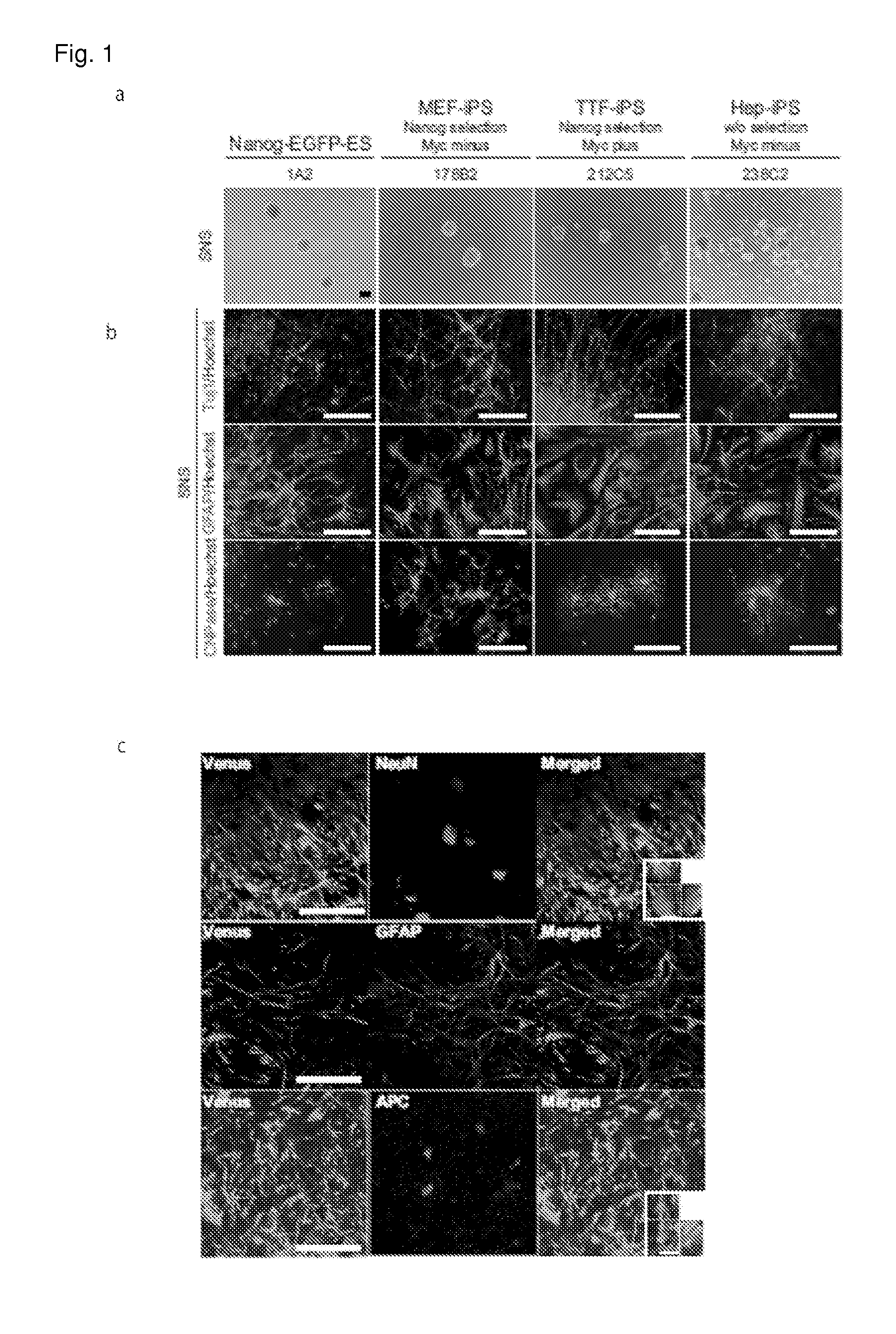Method for selecting clone of induced pluripotent stem cells
a technology stem cells, which is applied in the field of selecting a clone of induced pluripotent stem cells, can solve the problems of inability to deny the possibility of forming tumors due to reactivation of the introduced c-myc gene, and the inability to transplant ips cells thus produced, etc., to achieve efficient identification and selection of clones, high safety
- Summary
- Abstract
- Description
- Claims
- Application Information
AI Technical Summary
Benefits of technology
Problems solved by technology
Method used
Image
Examples
example 1
Differentiation of Respective iPS Cells into Neurons
[0065]36 clones of iPS cells were divided according to (1) the origins of iPS cells; i.e. MEF (Mouse Embryonic Fibroblast), TTF (Tail Tip Fibroblast), Hep (Hepatocyte) or Stm (Stomach epithelial cell); (2) with or without introduction of c-Myc-containing retrovirus; and (3) with or without selection in terms of expression of Nanog or Fbxo15. Profiles and results of analyses of each clone are shown in Tables 3 and 4. As control, the following three ES cell clones were used (RF8 (Meiner, V. L. et al., Proc Natl Acad Sci USA., 93(24):14041, 1996); 1A2, a subclone thereof having Nanog-EGFP reporter (Okita K, et al., Nature 448 (7151), 313, 2007); and EB3 having an Oct3 / 4 blasticidin resistant reporter gene (Mol Cell Biol., 22(5):1526, 2002 and Okada Y, et al., Stem cells 26 (12), 3086, 2008)). When these iPS cells and ES cells were allowed to form neurospheres containing neural stem cells and / or precursor cells (NS / PC), each of the iPS...
example 2
Activity of Nanog Promoter
[0068]It was examined how many undifferentiated cells are present in the SNSs.
[0069]In order to evaluate undifferentiated cells by flow cytometer, MEF-iPS cells, TTF-iPS cells, Hep-iPS cells and ES cells, all of them having Nanog-EGFP reporter, were used. These iPS cells have been established in various ways in the presence / absence of c-Myc-containing retrovirus, with / without selection in terms of the expression of Nanog, and the like. The SNSs derived from the MEF-iPS cells contained little or no Nanog-EGFP-positive cell irrespective of the presence of the c-Myc-containing retrovirus or the selection method (0 to 0.38%). This result is similar to that of the ES cell. On the other hand, the SNSs derived from the TTF-iPS cells contained a significantly larger number of Nanog-EGFP-positive undifferentiated cells (0.025 to 20.1%) in comparison to the cells derived from the MEF-iPS cells. The SNSs derived from the Hep-iPS cells also contained a larger number of...
example 3
Tumor Formation after Transplantation of SNS from Respective iPS Cells
[0070]In order to evaluate the SNSs derived from ES cells and iPS cells in vivo, the SNSs derived from each of the clones were transplanted into a corpus striatum of a NOD / SCID mouse in which tumor formation was examined (FIG. 3a and FIG. 3b). Mice which died or weakened after the transplantation were then dissected and healthy mice were dissected in 4 to 45 weeks after the transplantation.
[0071]Among 34 mice transplanted with SNSs derived from three ES cell clones, three died or weakened by tumor. The remaining 31 mice were also dissected, among which 30 mice did not have a tumor and only one was found to have a small tumor.
[0072]On the other hand, among 100 mice transplanted with SNSs derived from 12 MEF-iPS cell clones, nine died or weakened within 19 weeks after the transplantation. Tumor was found in eight of these nine mice. The remaining mice were also dissected, among which 66 mice did not have a tumor, wh...
PUM
| Property | Measurement | Unit |
|---|---|---|
| diameter | aaaaa | aaaaa |
| fluorescent | aaaaa | aaaaa |
| luminescent | aaaaa | aaaaa |
Abstract
Description
Claims
Application Information
 Login to View More
Login to View More - R&D
- Intellectual Property
- Life Sciences
- Materials
- Tech Scout
- Unparalleled Data Quality
- Higher Quality Content
- 60% Fewer Hallucinations
Browse by: Latest US Patents, China's latest patents, Technical Efficacy Thesaurus, Application Domain, Technology Topic, Popular Technical Reports.
© 2025 PatSnap. All rights reserved.Legal|Privacy policy|Modern Slavery Act Transparency Statement|Sitemap|About US| Contact US: help@patsnap.com



